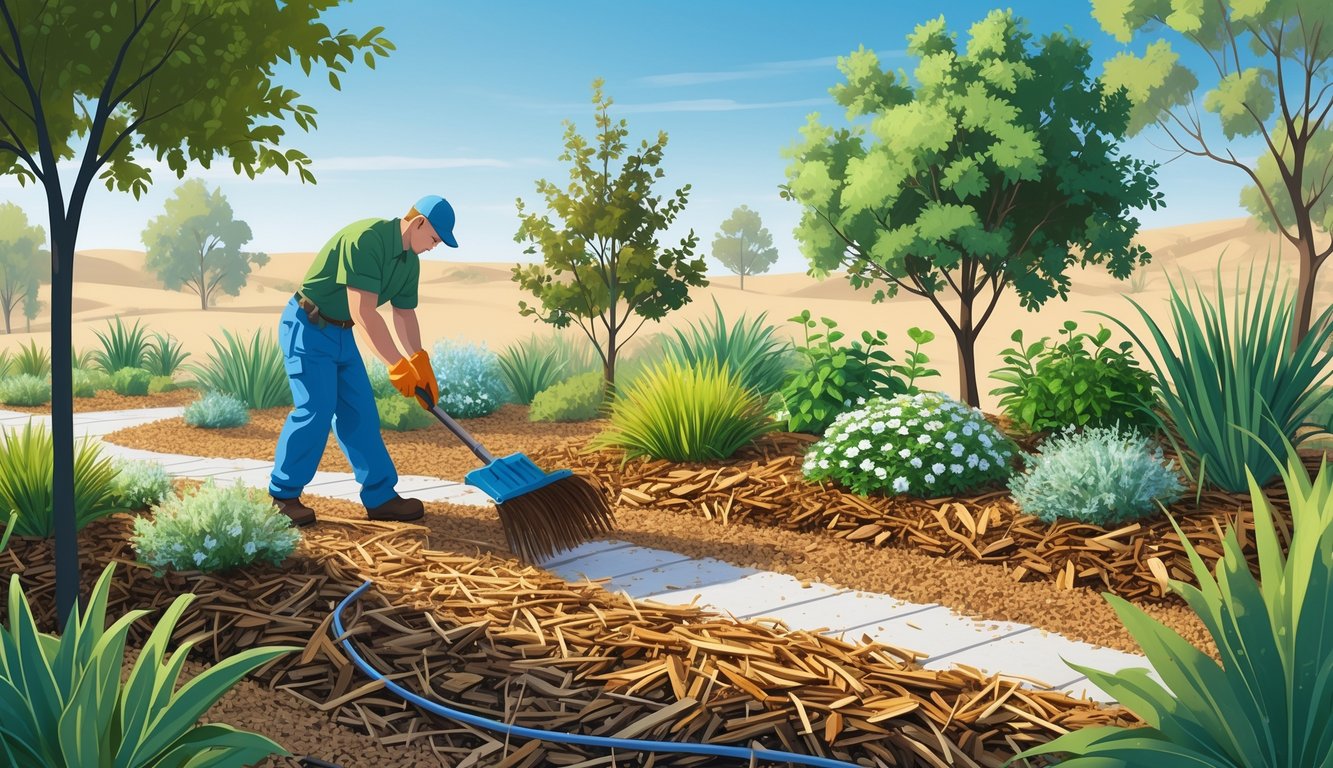
Best Practices for Mulching Application
Nobody just dumps mulch on dry dirt and wakes up to Eden. I’ve heard the horror stories. Getting the prep, depth, and timing right? That’s the difference between a garden and a disaster zone.
Proper Soil Preparation and Installation
Let’s talk prep. Nobody wants to do it, but skipping it is a rookie move. I’ve seen people just pour mulch over weeds and call it good. Don’t. Grab a rake, break up the dirt, pull out the clods, maybe even water it first so the mulch doesn’t just float away.
Tried mulching over Bermuda grass once. Big mistake. Pull the weeds, lay down cardboard (not the shiny stuff), and skip the landscape fabric unless you want to pick up shredded plastic later. Even the eco-friendly mulching crowd says stick with organic stuff so the worms and fungi can actually do their job. If your mulch smells like a landfill, toss it. Bad mulch kills the good microbes.
Anyone who skips this ends up with fungus gnats and regrets. Roots need air and real dirt contact, or you’re basically setting up a bug hotel, not helping with drought.
Recommended Mulch Depth and Coverage
Everyone says “two to four inches.” I say, sure, but three inches is the sweet spot if you want actual water savings and insulation. Someone always goes wild—five inches, eight inches. Seen it. Plants rot, ants move in, everything smells like vinegar.
My crews use measuring sticks, sometimes just hands—fluff it, check it, and always pull it back from stems so nothing rots. Coverage matters: leave bare patches and you’re just feeding weeds. But if you push it over the sidewalk, it bakes and crusts. Cover the roots, not the trunks, and keep an eye out for mold if it’s been dry forever.
If your mulch looks like a pillow instead of a blanket, you’re in trouble. Nobody talks about how uneven mulch depth attracts the weirdest bugs, but after a spring with earwigs in deep bark, I’m never forgetting.
Timing and Seasonal Considerations
Every March, I want to mulch because the neighbors do. Don’t. If the soil’s still cold, you’ll just stall everything out and invite slugs. Wait till the dirt’s at least 65°F. I use a thermometer, yes. Go too early, and you’ll regret it by July.
Spring is good for the first layer, but in drought years, I top off just before the first real heat wave. The idea is to trap the moisture you’ve got, not wish for rain after the fact. This guide says timing is half the battle, and I believe it. Mulch after rain, let things dry a bit, then go for it.
I tried mulching in a week-long drizzle once. Spent days chasing wood chips down the street. Neighbors laughed. Lesson learned. Fall’s weird—sometimes you need mulch for overwintering perennials, but pile it too soon and you get mushrooms. Not the tasty kind, either.
Maximizing Water Efficiency with Mulch
I’ve stood there, shovel in hand, wondering if mulch was even worth the sweat. But honestly, when you get it right, water bills drop—sometimes by half. Drip tubing under mulch? Game changer. Mulch isn’t just weed control. It works with irrigation lines and rain barrels, trapping every drop before the sun can steal it. I can’t pretend it’s not impressive.
Integrating Drip Irrigation Systems
I’ve learned the hard way—landscape fabric is not your friend if you want to use drip irrigation. I run emitter tubing straight under a thick mulch layer, usually about three inches, right up to the base of each plant. Organic mulch (shredded bark, cocoa hulls, straw—never, ever rubber) keeps the water where it belongs. Supposedly, this combo can cut water use by 70%. Maybe that’s optimistic, but it’s not nothing.
Last seminar I went to, everyone argued about where to put the drip lines—too high, they dry out; too low, roots get soggy and mildew takes over. Mulch slows runoff, lets the dirt soak it up. “Regulate your zone timing,” some extension agent barked at us. “Don’t drown your roots.” Honestly, he was right.
Rainwater Harvesting and Mulch Synergy
So, rain barrels: everyone’s obsessed until they overflow after a single storm, and then it’s just a mosquito breeding ground on the patio. But mulch? I swear, nobody gives it enough credit. Every time I dump a pile under a rain chain, it soaks up the flood and slowly feeds it out to the roots. Like, I actually see the difference—plants hanging on way longer after a downpour. I aim for 2–4 inches, but honestly, sometimes I just eyeball it. That, plus the rainwater, and the beds don’t dry out nearly as fast.
And why does nobody mention the gross puddles along the sidewalk? I keep moving overflow zones around and throwing down chipped bark or half-rotted leaves, and suddenly the neighbor’s hydrangeas look less dead in July. Supposedly, mulched strips cut runoff by up to 80%. Is that real? I mean, maybe, but I do notice less water pooling where I actually bother with mulch.
Reducing Water Loss and Evaporation
Isn’t it always the hottest day when you realize bare dirt just bakes? I swear, water just vanishes—gone in an hour. Mulched beds, though, stay cool. Like, I’ve actually touched the soil and it’s almost cold compared to the rest of the yard. Four inches of mulch, and I get two, sometimes three more days before I have to drag out the hose.
My neighbor won’t shut up about chip size—fine stuff mats, big stuff lets in air, whatever. I just use whatever’s on sale. These eco-friendly mulching guides say thickness matters most. I guess that checks out, because the water bill drops when I bother to keep the mulch deep. The only downside? That weird steam cloud when you water after a hot day. Looks like a sauna, but for weeds.